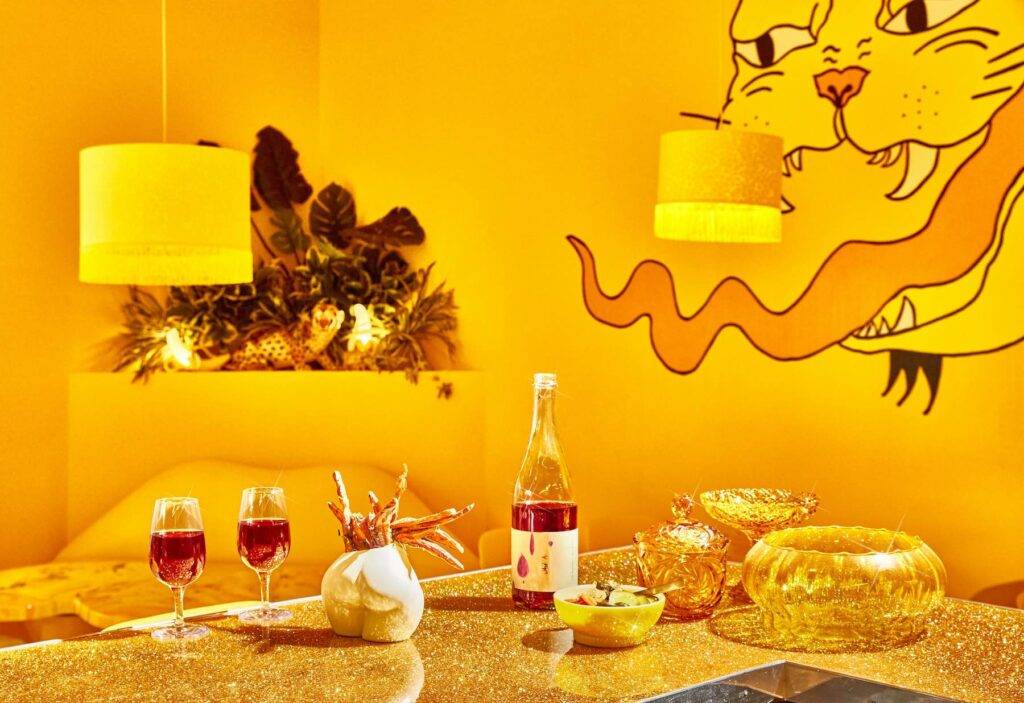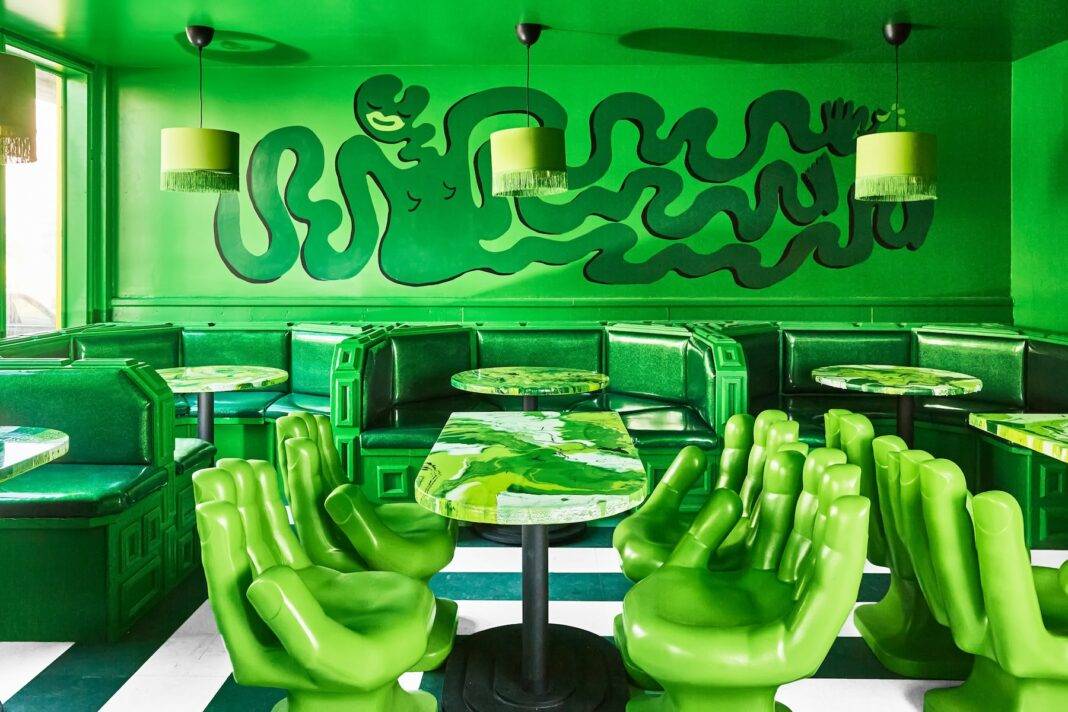The owners of San Francisco’s Shuggie’s Trash Pie restaurant fight food waste deliciously.
Customers arriving at Shuggie's Trash Pie + Natural Wine in San Francisco’s Mission District are greeted with a playful green and yellow façade and the promise of “hot pizza, cold wine.”
Inside, the dining rooms are also green and yellow (think: Jolly Green Giant, bananas), and customers sit beneath a tiger mural in green chairs shaped like open hands. A nearby bar counter is painted with green glitter. If you order the Goddess, a starter of surplus greens tossed in spicy avocado dressing with aged Gouda cheese, it will arrive at your table served in a container shaped like a woman’s bust — presumably that of the Goddess.
But while the vibe is fanciful, the message is serious: Tackle food waste by using imperfect produce, off-cuts of meat, food manufacturing byproducts, not-in-demand seafood, and other undesirable and surplus ingredients. Add bold flavors via the generous use of spices and sauces. Draw attention to the mission by serving food in an Instagrammable décor and by giving the whole endeavor an in-your-face name.
“The issue of food waste is too often sequestered to the land of hard activism and fine-dining,” says Kayla Abe, who co-owns Shuggie’s with her life partner, David Murphy. “We want to make a serious, pressing issue more accessible and cheaper, using the vehicle of pizza. It’s always a party when pizza is around. We want the element of fun. When they’re enjoying themselves, people are far more engaged. We do the sustainable back-end, and they can look into how we do it and learn.”
“We’ve all been trained for decades to find the perfect tomato — one without a blemish, one that’s ripe and juicy, without a knob or scar,” Murphy told Eating Trash, a 2023 CBS Reports show on chefs’ efforts to curb food waste. In 2021, the report found, eighty million tons of food was wasted in the US — more than half from residential households, but sixteen percent from the food service industry. Four to ten percent of restaurant food never gets served, and more than a third of the food served to customers isn’t eaten.

Motivated by taste alone, I’m not fussy about how my food looks in the raw. I ordered a Shuggie's Cheddah and Feta pizza, packed with broccoli, including its stalks (pureed into pesto) and leaves. The dough is made with whey, a byproduct of cheese-making, and spent oat flour, a byproduct of oat milk production. A honey and chile oil add-on was free; anchovies were four dollars extra. The whole thing was utterly delicious.
A cauliflower dish utilized the entire plant — stalks, leaves, and florets. It, too, was delicious, thanks to a yellow aji amarillo Romesco sauce (made with a chile pepper popular in Peruvian cooking and discolored walnuts), chimichurri (a vinegary parsley, oregano and garlic sauce), and cotija cheese. A polenta dish covered in parmesan-crusted fried green tomatoes, chile-tossed sungold tomatoes, and charred okra made the blemished veggies irrelevant. A crispy squid dish that included black squid ink was accompanied by pickled green tomatoes and toum (a sauce of Lebanese garlic, lemon juice, and oil). Captain Beefheart, a spicy meatball dish with labneh, harissa, and cauliflower leaf emulsion, used ground beef hearts. Many of these are not ingredients you’ll find in most restaurant kitchens, but Shuggie’s makes them shine.
Abe, 30, a San Francisco native of Chinese-Japanese descent, and Murphy, 39, a Texas native, opened Shuggie’s in 2021 during COVID. Before that, they operated Ugly Pickle, which made pickles from irregular cucumbers. Prior to that, Abe worked at Oatly, the oat milk company, and CUESA (Center for Urban Education About Sustainable Agriculture), now called Foodwise — the nonprofit that’s run San Francisco farmers’ markets since 1994. Murphy, a chef with over 20 years of fine-dining experience who creates all of the recipes at Shuggie’s, worked at Madera in the Rosewood Sand Hill hotel in Menlo Park, Whitechapel, a gin-dominated cocktail lounge with global eats in San Francisco, and Uchi, a Japanese restaurant in Austin. The pair met at the Ferry Building Marketplace farmers’ market.
Abe and Murphy source their ingredients from Lucero Organic Farms in Sacramento County, Monterey Fish Market in San Francisco, and Cream Co. Meats, a whole-animal butcher in Oakland, among others. Together, they picked the restaurant’s color scheme, painted the tiger mural, and even constructed and marbleized the tables. (“Thank goodness for YouTube,” Abe says). “We love San Francisco and wanted to bring back its quirky and expressive vibe.”


